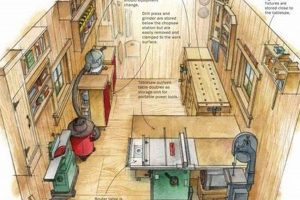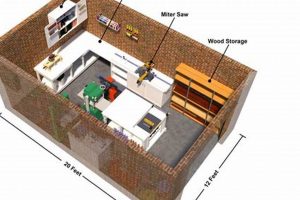
Strategic arrangement blueprints for crafting workspaces enable efficient workflows and maximize the utility of available space. These schematics detail the positioning of machinery, workbenches, storage solutions, and pathways to optimize movement and... Read more »

The spatial arrangement of tools, machinery, and workspaces within a woodworking environment directly impacts efficiency and safety. A well-considered organizational structure streamlines workflow, minimizes unnecessary movement, and reduces the risk of accidents.... Read more »

The spatial arrangement of a dedicated area for woodworking activities, incorporating the placement of tools, machinery, work surfaces, and storage, is a critical element in achieving efficiency and safety. Considerations include workflow... Read more »

Precision in woodworking begins with accurate marking and measurement. Instruments employed for this purpose guide the cutting, shaping, and joining of wood components. Examples include squares for ensuring right angles, rulers and... Read more »

Effective arrangement of a limited-space workshop is paramount to achieving efficient and safe woodworking practices. This arrangement involves careful consideration of workflow, machinery placement, storage solutions, and safety protocols within a confined... Read more »

The efficient arrangement of tools, equipment, and workspace within a typical two-automobile capacity residential structure to facilitate woodworking activities represents a significant consideration for hobbyists and professionals alike. This organization necessitates careful... Read more »

The organization of a dedicated space for fabrication using wood is a critical aspect of efficient and safe project execution. Careful consideration should be given to the arrangement of tools, machinery, material... Read more »

Precise marking instruments and techniques are fundamental to the craft of woodworking. These implements, utilized before any material is cut or shaped, ensure accuracy and minimize errors in the construction process. Examples... Read more »

The configuration of a designated area within a residence for the purpose of fabricating items primarily from wood involves careful consideration of several factors. These factors include available square footage, the intended... Read more »

The arrangement of tools, equipment, work surfaces, and storage within a residential vehicle storage space to facilitate efficient and safe woodworking activities constitutes a dedicated workshop environment. An example includes positioning a... Read more »


